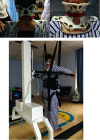Design of Personalized Cervical Fixation Orthosis Based on 3D Printing Technology
- PMID: 35535322
- PMCID: PMC9078801
- DOI: 10.1155/2022/8243128
Design of Personalized Cervical Fixation Orthosis Based on 3D Printing Technology
Abstract
The movement of the cervical spine should be restricted throughout the rehabilitation phase after it has been injured. Cervical orthosis is commonly utilized in clinical settings to guarantee cervical spine stability. However, to date, the investigations are limited to patient-specific cervical fixation orthoses. This study provides a new idea for making personalized orthoses. The CT data of the patient's cervical spine were collected, then mimics were used for reconstructing the skin of the cervical spine, the Geomagic Studio was used for surface fitting, the Inspire Studio was used for structural topology optimization, redundant structures were removed, the resulting orthotics were postprocessed, and finally, it was printed with a 3D printer. No signs of pain or discomfort were observed during the wearing. The cervical spine range of motion in flexion, extension, lateral flexion, and rotation is all less than 8° after using the device. Low cost, quick manufacturing time, high precision, attractive appearance, lightweight structure, waterproof design, and practical customized orthotics for patients are all advantages of 3D printing technology in the field of orthopedics. Many possible benefits of using 3D printing to build new orthotics include unique design, stiffness, weight optimization, and improved biomechanical performance, comfort, and fit. Personalized orthotics may be designed and manufactured utilizing 3D printing technology.
Copyright © 2022 Yangyang Xu et al.
Conflict of interest statement
All the authors declare that there is no conflict of interest regarding the publication of this article.
Figures





Similar articles
-
Multilevel 3D Printing Implant for Reconstructing Cervical Spine With Metastatic Papillary Thyroid Carcinoma.Spine (Phila Pa 1976). 2017 Nov 15;42(22):E1326-E1330. doi: 10.1097/BRS.0000000000002229. Spine (Phila Pa 1976). 2017. PMID: 28498291
-
Comparison of the immobilizing effect of soft, semi-rigid and rigid neck orthoses.Eur Spine J. 2025 Apr 16. doi: 10.1007/s00586-025-08854-5. Online ahead of print. Eur Spine J. 2025. PMID: 40234294
-
Advances in 3D printed orthotics for rehabilitation.Wiad Lek. 2025;78(3):539-543. doi: 10.36740/WLek/202602. Wiad Lek. 2025. PMID: 40219879 Review.
-
3D printing technology applied to orthosis manufacturing: narrative review.Ann Palliat Med. 2020 Nov;9(6):4262-4270. doi: 10.21037/apm-20-1185. Epub 2020 Sep 24. Ann Palliat Med. 2020. PMID: 33040564 Review.
-
The Future of Biomechanical Spine Research: Conception and Design of a Dynamic 3D Printed Cervical Myelography Phantom.Cureus. 2019 May 3;11(5):e4591. doi: 10.7759/cureus.4591. Cureus. 2019. PMID: 31309016 Free PMC article.
Cited by
-
Automated design of nighttime braces for adolescent idiopathic scoliosis with global shape optimization using a patient-specific finite element model.Sci Rep. 2024 Feb 8;14(1):3300. doi: 10.1038/s41598-024-53586-z. Sci Rep. 2024. PMID: 38332053 Free PMC article.
-
Recent advances of 3D-printing in spine surgery.Surg Neurol Int. 2024 Aug 23;15:297. doi: 10.25259/SNI_460_2024. eCollection 2024. Surg Neurol Int. 2024. PMID: 39246777 Free PMC article. Review.
-
The NuroSleeve, a user-centered 3D printed hybrid orthosis for individuals with upper extremity impairment.J Neuroeng Rehabil. 2023 Aug 4;20(1):103. doi: 10.1186/s12984-023-01228-2. J Neuroeng Rehabil. 2023. PMID: 37542335 Free PMC article. Clinical Trial.
-
3D Printing for Personalized Solutions in Cervical Spondylosis.Orthop Res Rev. 2024 Oct 17;16:251-259. doi: 10.2147/ORR.S486438. eCollection 2024. Orthop Res Rev. 2024. PMID: 39435304 Free PMC article. Review.
-
Clinical case study on custom 3D printed collars for dropped head syndrome patients.3D Print Med. 2025 Jun 5;11(1):23. doi: 10.1186/s41205-025-00274-x. 3D Print Med. 2025. PMID: 40471434 Free PMC article.
References
LinkOut - more resources
Full Text Sources

